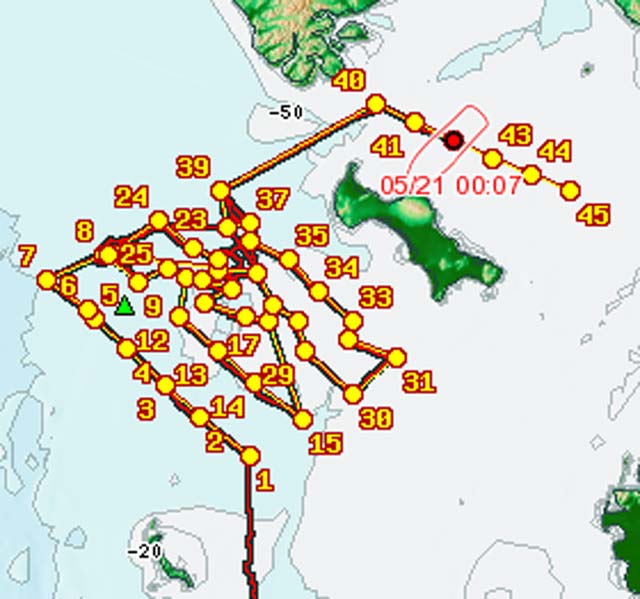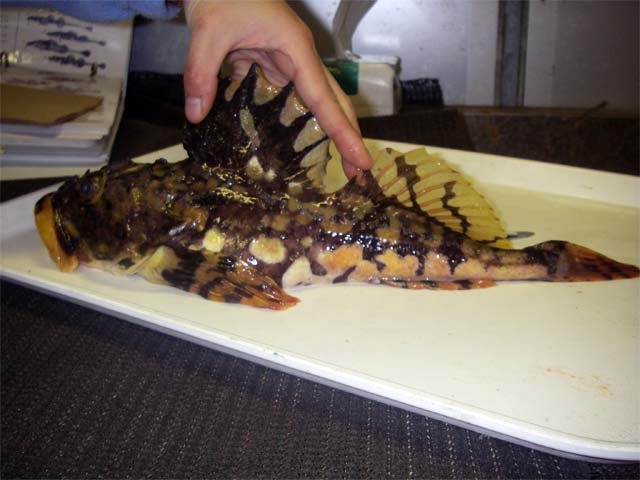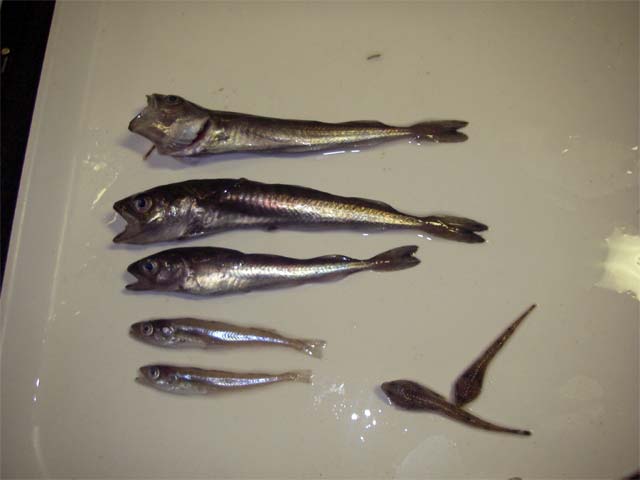( Log In ) Log In is for TREC Teachers & Researchers only
  |
| Samantha_Dassler_Barlow |
 May 22 2006, 06:54 PM May 22 2006, 06:54 PM
Post
#1
|
 Advanced Member    Group: TREC Team Posts: 99 Joined: 12-April 06 Member No.: 23 |
Date: Saturday, May 21, 2006
Latitude: 64° 19.9’ N Longitude: 169° 36.2’ W  We have moved north of St. Lawrence Island and we are now at the southern end of the Bering Strait. After a foggy, eerie night where the water looked like black glass fractured by white chunks of scattered ice, we woke up to a bright, sunny day and a deep blue, glittering sea. This is the first sunny day that we have seen in over a week! We are about as close as we will get to Russia and it was amazing to see it in the distance. People took a ton of pictures of the soft, snow-covered mountains. I had a time of sticking my lens up to a pair of binoculars to get the best picture I could get of another continent. Before the Bering Sea, Belize, Central America is the furthest I have ever traveled. It is also the only time I have been out of this country. You can probably understand, then, that it was very special for me to see another continent besides our own. Since I am traveling around the Bering Sea, does that count as having been out of the country? By the way, I think we’ve crossed the International Dateline too.  If you look very closely – and I mean very closely – at the horizon, then maybe you can see the white peaks of Russia that I could see very well through the binoculars.  Russia’s white peaks became a little more visible after cropping and zooming in on the previous picture.  Patty and I enjoyed the sunshine from the bridge for most of the day. The glittering sea was so bright today! We visited the HCO Shack, or Helo Shack as they commonly call it here on the ship. It is the small control tower that is located one deck above the helo deck. We watched Alex Stone, the helo manager, load the passengers into the helo and then listened to the intricate, back and forth communication of the bridge, pilot, and control. Captain Oliver was there to observe. Later in the day, one of the smaller boats took off with a crew that was studying ice seals. I can’t help but think that Captain Oliver might have felt much like I do when I have different groups of students off doing projects in different places on our campus – worried about where everyone is and if they are safe!  A view of the departing helo from the Helo Shack. Out on the fantail, the scientists were busy with the sampling as usual, only this time, they are pulling up new and exciting critters! The bottom has changed from the slimy, oozy, greenish-grey mud full of brittle stars, to a hard, rocky bottom. The critters usually draw a lot of attention from kids, adults, and other scientists even though they are only small parts of the whole ecosystem. This might make some of the other scientists feel a little left out when they are studying things that you can’t see very well but are equally important in the grand scheme of things. Quite a few of my journals will be devoted to them soon enough, but for now, look what came up in the vanVeen grabs and the trawl net!  Look at these giant barnacles that came up in the vanVeen grab! Barnacles are invertebrate animals in the phylum of arthropods, which means that they do not have a backbone and they have jointed legs. They are in the class of arthropods called crustaceans, so they are closely related to shrimp, crabs, and lobsters. Other classes of arthropods include insects and spiders.  If you look closely around the giant barnacles, you start to see a whole ecosystem of critters – worms, urchins, ascidians, bryozoans, tunicates, crabs, and more!  Critters from the vanVeen on May 20, 2006: a feisty little crab. Crabs are in the invertebrate phylum of arthropods and the class called crustaceans. They have an exoskeleton made of a hard substance called chitin. They grow by molting, or shedding, an outside layer of their exoskeleton when a new one is ready underneath.  Critters from the vanVeen on May 20, 2006: a teensy weensy tiny little sea urchin. Sea urchins are animals in the invertebrate phylum of echinoderms, which means that they are related to sea stars (starfish), but they are in a different class than sea stars. Sea urchins are in the class called echinoidea, while sea stars are in the class called asteroidea.  Critters from the vanVeen on May 20, 2006: many small urchins. Sea urchins are animals in the invertebrate phylum of echinoderms, which means that they are related to sea stars (starfish), but they are in a different class than sea stars. Sea urchins are in the class called echinoidea, while sea stars are in the class called asteroidea. They have radial symmetry and spines on their surface.  Critters from the otter trawl on May 20, 2006: a fish called a sculpin. Fish that have skeletons composed of bone are in a class of cold-blooded, vertebrate animals called osteichthyes. Sculpins are in the family called cottidae.  Critters from the otter trawl on May 20, 2006: the five silver fish on the left are called arctic cod while the 2 fish small fish in the lower right corner are called snailfish. Special thanks to the National Audubon Society (NAS) Field Guide to North American Fishes, Whales & Dolphins and the NAS Pocket Guide: Familiar Seashore Creatures of North America. |
  |
1 User(s) are reading this topic (1 Guests and 0 Anonymous Users)
0 Members:

|
NSF Acknowledgment & Disclaimer | Time is now: 18th November 2024 - 10:51 AM |
Invision Power Board
v2.1.7 © 2024 IPS, Inc.








